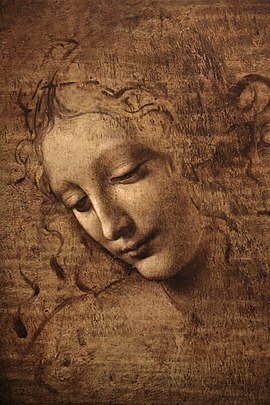| La Scapigliata | |
|---|---|
| English: The Lady with Dishevelled Hair | |
 | |
| Artist | Leonardo da Vinci |
| Year | c. 1506–1508 (unfinished) |
| Medium | Oil, umber, and white lead pigments on poplar wood panel |
| Dimensions | 24.7 cm × 21 cm (9.7 in × 8.3 in) |
| Location | Galleria Nazionale, Parma |
La Scapigliata (Italian for 'The Lady with Dishevelled Hair')[n 1] is an unfinished painting generally attributed to the Italian High Renaissance artist Leonardo da Vinci, and dated c. 1506–1508. Painted in oil, umber, and white lead pigments on a small poplar wood panel, its attribution remains controversial, with several experts attributing the work to a pupil of Leonardo. The painting has been admired for its captivating beauty, mysterious demeanor, and mastery of sfumato.
There is no real consensus on the subject, date, history, or purpose of the painting. It shows an unidentified woman gazing downward while her hair fills the frame behind her. Many theories regarding the subject have been proposed: that it is a sketch for an uncompleted painting of Saint Anne; a study for the London version of the Virgin of the Rocks or Leonardo's lost painting of Leda and the Swan; or a painting left deliberately unfinished for its aesthetic value.
The painting was recorded in the sale in 1826 of Gaetano Callani's collection to the Galleria Nazionale di Parma, the museum in which it is currently housed, but proof of its existence may date back to 1531, when it may have been owned by Isabella d'Este. Although many studies of Leonardo's oeuvre are silent on the issue, most scholars who discuss the painting regard it as an autographic work by Leonardo da Vinci and it has been listed as such in various major Leonardo exhibitions.
Cite error: There are <ref group=n> tags on this page, but the references will not show without a {{reflist|group=n}} template (see the help page).